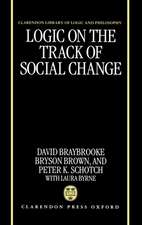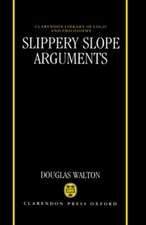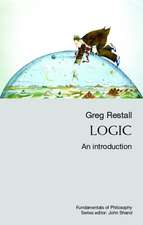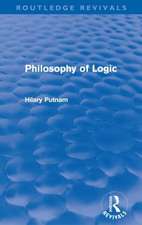Constructivity and Computability in Historical and Philosophical Perspective: Logic, Epistemology, and the Unity of Science, cartea 34
Editat de Jacques Dubucs, Michel Bourdeauen Limba Engleză Hardback – 9 sep 2014
Focusing on the growing pains computability experienced as it was forced to address the demands of rapidly expanding applications, the content maps the developments following Turing’s ground-breaking linkage of computation and the machine, the resulting birth of complexity theory, the innovations of Kolmogorov complexity and resolving the dissonances between proof theoretical semantics and canonical proof feasibility. Finally, it explores one of the most fundamental questions concerning the interface between constructivity and computability: whether the theory of recursive functions is needed for a rigorous development of constructive mathematics.
This volume contributes to the unity of science by overcoming disunities rather than offering an overarching framework. It posits that computability’s adoption of a classical, ontological point of view kept these imperatives separated. In studying the relationship between the two, it is a vital step forward in overcoming the disagreements and misunderstandings which stand in the way of a unifying view of logic.
| Toate formatele și edițiile | Preț | Express |
|---|---|---|
| Paperback (1) | 362.12 lei 38-45 zile | |
| SPRINGER NETHERLANDS – 10 sep 2016 | 362.12 lei 38-45 zile | |
| Hardback (1) | 375.45 lei 38-45 zile | |
| SPRINGER NETHERLANDS – 9 sep 2014 | 375.45 lei 38-45 zile |
Din seria Logic, Epistemology, and the Unity of Science
- 15%
 Preț: 645.60 lei
Preț: 645.60 lei - 18%
 Preț: 1233.06 lei
Preț: 1233.06 lei - 18%
 Preț: 995.94 lei
Preț: 995.94 lei - 18%
 Preț: 1712.87 lei
Preț: 1712.87 lei - 18%
 Preț: 945.62 lei
Preț: 945.62 lei - 18%
 Preț: 1235.25 lei
Preț: 1235.25 lei - 18%
 Preț: 1224.06 lei
Preț: 1224.06 lei - 18%
 Preț: 955.70 lei
Preț: 955.70 lei - 15%
 Preț: 644.95 lei
Preț: 644.95 lei - 24%
 Preț: 1058.23 lei
Preț: 1058.23 lei - 20%
 Preț: 558.63 lei
Preț: 558.63 lei - 24%
 Preț: 878.92 lei
Preț: 878.92 lei - 18%
 Preț: 1236.99 lei
Preț: 1236.99 lei - 24%
 Preț: 896.30 lei
Preț: 896.30 lei - 24%
 Preț: 791.27 lei
Preț: 791.27 lei - 24%
 Preț: 727.49 lei
Preț: 727.49 lei - 24%
 Preț: 789.90 lei
Preț: 789.90 lei - 20%
 Preț: 561.68 lei
Preț: 561.68 lei - 20%
 Preț: 560.31 lei
Preț: 560.31 lei - 20%
 Preț: 568.74 lei
Preț: 568.74 lei - 24%
 Preț: 1046.22 lei
Preț: 1046.22 lei - 24%
 Preț: 698.18 lei
Preț: 698.18 lei - 20%
 Preț: 549.89 lei
Preț: 549.89 lei - 18%
 Preț: 958.73 lei
Preț: 958.73 lei - 20%
 Preț: 580.53 lei
Preț: 580.53 lei - 20%
 Preț: 561.44 lei
Preț: 561.44 lei
Preț: 375.45 lei
Nou
Puncte Express: 563
Preț estimativ în valută:
71.84€ • 76.82$ • 59.90£
71.84€ • 76.82$ • 59.90£
Carte tipărită la comandă
Livrare economică 14-21 aprilie
Preluare comenzi: 021 569.72.76
Specificații
ISBN-13: 9789401792165
ISBN-10: 940179216X
Pagini: 228
Ilustrații: XI, 214 p. 1 illus.
Dimensiuni: 155 x 235 x 20 mm
Greutate: 0.5 kg
Ediția:2014
Editura: SPRINGER NETHERLANDS
Colecția Springer
Seria Logic, Epistemology, and the Unity of Science
Locul publicării:Dordrecht, Netherlands
ISBN-10: 940179216X
Pagini: 228
Ilustrații: XI, 214 p. 1 illus.
Dimensiuni: 155 x 235 x 20 mm
Greutate: 0.5 kg
Ediția:2014
Editura: SPRINGER NETHERLANDS
Colecția Springer
Seria Logic, Epistemology, and the Unity of Science
Locul publicării:Dordrecht, Netherlands
Public țintă
ResearchCuprins
Preface; Jacques Dubucs and Michel Bourdeau.- Chapter 1. Constructive Recursive Functions, Church’s Thesis, and Brouwer’s Theory of the Creating Subject: Afterthoughts on a Parisian Joint Session; Göran Sundholm.- Chapter 2. The developments of the concept of machine computability from 1936 to the 1960s; Jean Mosconi.- Chapter 3. Kolmogorov Complexity in perspective, Part I: Information Theory and Randomness; Marie Ferbus-Zanda and Serge Grigorieff.- Chapter 4. Kolmogorov Complexity in perspective, Part II: Classification, Information Processing and Duality; Marie Ferbus-Zanda.- Chapter 5. Proof-theoretic semantics and feasibility; Jean Fichot.- Chapter 6. Recursive functions and constructive mathematics; Thierry Coquand.- Chapter 7. Gödel and intuitionism; Mark van Atten.
Textul de pe ultima copertă
Ranging from Alan Turing’s seminal 1936 paper to the latest work on Kolmogorov complexity and linear logic, this comprehensive new work clarifies the relationship between computability on the one hand and constructivity on the other. The authors argue that even though constructivists have largely shed Brouwer’s solipsistic attitude to logic, there remain points of disagreement to this day.
Focusing on the growing pains computability experienced as it was forced to address the demands of rapidly expanding applications, the content maps the developments following Turing’s ground-breaking linkage of computation and the machine, the resulting birth of complexity theory, the innovations of Kolmogorov complexity, and resolving the dissonances between proof theoretical semantics and canonical proof feasibility. Finally, it explores one of the most fundamental questions concerning the interface between constructivity and computability: whether the theory of recursive functions is needed for a rigorous development of constructive mathematics.
This volume contributes to the unity of science by overcoming disunities rather than offering an overarching framework. It posits that computability’s adoption of a classical, ontological point of view kept these imperatives separated. In studying the relationship between the two, it is a vital step forward in overcoming the disagreements and misunderstandings which stand in the way of a unifying view of logic.
Focusing on the growing pains computability experienced as it was forced to address the demands of rapidly expanding applications, the content maps the developments following Turing’s ground-breaking linkage of computation and the machine, the resulting birth of complexity theory, the innovations of Kolmogorov complexity, and resolving the dissonances between proof theoretical semantics and canonical proof feasibility. Finally, it explores one of the most fundamental questions concerning the interface between constructivity and computability: whether the theory of recursive functions is needed for a rigorous development of constructive mathematics.
This volume contributes to the unity of science by overcoming disunities rather than offering an overarching framework. It posits that computability’s adoption of a classical, ontological point of view kept these imperatives separated. In studying the relationship between the two, it is a vital step forward in overcoming the disagreements and misunderstandings which stand in the way of a unifying view of logic.
Caracteristici
Offers an in depth look at the relationship between computability and constructivity Follows the developments from Turing's ground-breaking linkage between computation and the machine and the final resolution between proof theoretical semantics and canonical proof feasibility Examines how to bridge differences in the area rather than providing a comprehensive view over the work












